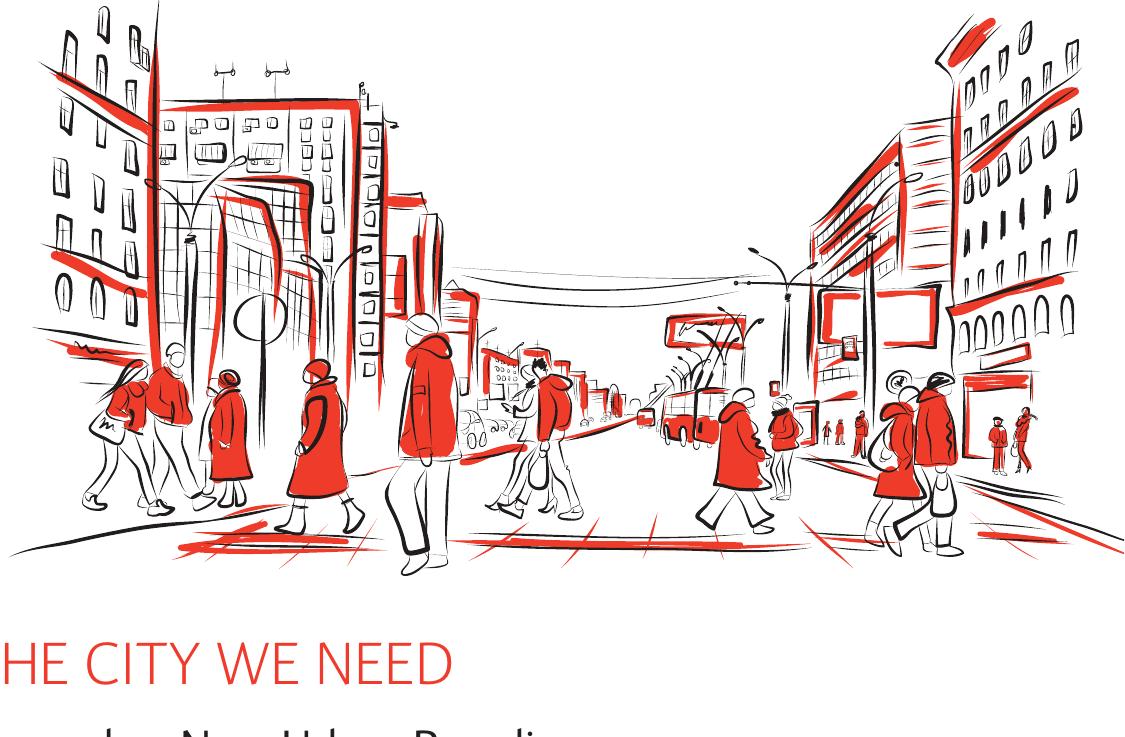The City We Need
Sign up for access to the world's latest research
Abstract
AI
AI
The document outlines a collaborative vision for urban development in the 21st century, emphasizing the urgent need for a New Urban Agenda ahead of the Habitat III Conference. Key principles are established to guide sustainable urban planning, aiming to mitigate issues of segregation, inequality, and environmental degradation. Additionally, the World Urban Campaign encourages local engagement through grassroots initiatives, fostering individual commitment to enhance urban environments.
Related papers
Two decades into the 21st century, and the City, one of the most complex human artefacts, continues its transformation. Urbanization processes carry on in different ways and pace across the globe. Along with it, the complexity of urban problems increases and the public debate for their solutions intensifies, while the key urban questions remain classical: How do we imagine cities and urban development in the decades to come? And how do we make it happen?
The UN-HABITAT III conference held in Quito in late 2016 enshrined the first Sustainable Development Goal (SDG) with an exclusively urban focus. SDG 11, as it became known, aims to make cities more inclusive, safe, resilient and sustainable through a range of metrics, indicators, and evaluation systems. It also became part of a post-Quito 'New Urban Agenda' that is still taking shape. This paper raises questions around the potential for reductionism in this new agenda, and argues for the reflexive need to be aware of the types of urban space that are potentially sidelined by the new trends in global urban policy.
Raum Planung, 2017
Despite a global consensus to foster National Urban Policies (NUPs) as a key vehicle to achieving the New Urban Agenda, it remains unclear what constitutes a NUP and how it can help catalyse the New Urban Agenda in all 193 member states of the United Nations. National Urban Policies: a policy lever to foster a New Urban Agenda? addresses these two questions and explores the relevance of national polcies in the context of a New Urban Agenda for Cities. The article looks at typologies of NUPs to investigate how the policies can accommodate the commitments made at Habitat III in Quito within the New Urban Agenda. It also reviews the current body of academic literature as well as policy assessments to analyse and categorise a sample of 19 countries with an explicit National Urban Policy in place. Based on these findings, the article closes with a number of reflections on the potential pitfalls of promoting the New Urban Agenda through National Urban Policies.
The Urban Environmental Accord (UEA), 2017
The United Nations specialized agency on Human Settlements UN-Habitat, is by mandate leading the work in defining the top level sectorial policies on human settlements, through the United Nation Conferences on Human Settlements, known as HABITAT. The first HABITAT conference was held in Vancouver in 1976, followed by HABITAT II in Istanbul in 1996, when the Istanbul Declaration on Human Settlements was approved. The Habitat Agenda was set in Istanbul, in the frame of the United Nations Conference on Environment and Development and the Rio Declaration, which established the Agenda 21 defining a decidedly local strategy and action plan to achieve adequate shelter for all and sustainable human settlements in an urbanizing world. In 2016 HABITAT III, the United Nations Conference on Housing and Sustainable Urban Development, took place in Quito, and the New Urban Agenda was adopted, setting up a sustainable urbanization strategy and action plan for the next 20 years, anchored to the concept of cities for all, promoting inclusivity based on the equal use and enjoyment of cities, towns, and villages. It is designed to produce just, safe, healthy, accessible, resilient, and sustainable cities and human settlements that are understood as a common good that essentially contributes to prosperity and quality of life for present and future generations. The New Urban Agenda is a set global standards of achievement in sustainable urban development, rethinking the way we build, manage, and live in cities through drawing together cooperation with committed partners, relevant stakeholders, and urban actors at all levels of government as well as the private sector. The Agenda stresses that tackling air pollution in cities is good both for people’s health and for the planet and through it, leaders have committed to increase their use of renewable energy, provide better and greener public transport, and sustainably manage their natural resources. The Agenda’s ‘shared vision’ aims to create conditions for communities and policy makers to create that are engines of sustained and inclusive economic growth, social and cultural development, and environmental protection. Among the key provisions are a call for equal opportunities for all an end to discrimination cleaner cities strengthening resilience and reducing carbon emissions fully respecting regardless of their status improving connectivity and green initiatives, and promoting “safe accessible and green public spaces.”
Tailoring Urban Growth: Lessons from Lebanon, Jordan, and Egypt's National Urban , 2024
This paper critiques the UN-Habitat National Urban Policy framework's effectiveness in guiding sustainable urban development, especially its limitations in addressing diverse regional contexts. Case studies from Lebanon, Jordan, and Egypt highlight the framework's "one-size-fits-all" approach, revealing its inadequacy in managing challenges such as political instability, refugee integration, and environmental degradation. The paper advocates for participatory urban planning incorporating context-specific solutions to achieve equitable and sustainable urban growth.
2016
2014 (3.88 billion) 2030 (5.06 billion) Megacities > 10 mill. 453 mill. (12 percent) 759 mill. (15 percent) Large cities 5-10 mill. 300 mill. (8 percent) 400 mill. (9 percent) Medium cities 1-5 mill. 827 mill. (21 percent) 1.100 mill. (22 percent) Small cities 300,000-1 mill. 521 mill. (13 percent) 828 mill. (16 percent) <300,000 1.670 mill. (43 percent) 1.920 mill.

Loading Preview
Sorry, preview is currently unavailable. You can download the paper by clicking the button above.
 Ta ThuHuong
Ta ThuHuong















